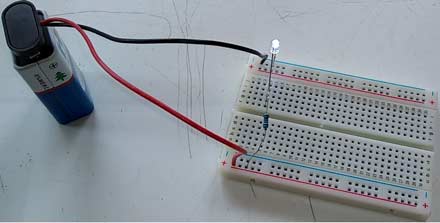
___________________________
A battery (source) produces electricity because it causes electrons to flow. When a reasonable amount these electrons are made to pass through a light emmiting diode (LED), the LED glows. Electrons move from the negatively charged anode of a battery toward the positively charged cathode. The current flowing through a circuit is measured in amps. Note that, too much current can damage the LED and drain your batteries too fast. Therefore, electrical devices called resistors are highly needed to restrict the flow of electricity, preventing too much from flowing from the source, protecting the LED from damage.
■ Snap the battery clip to the battery
■ Now connect the positive terminal of the battery to the positive horizontal path of the breadboard.
■ Connect the negative terminal of the battery to the negative horizontal path of the breadboard.
■ connect the 1k resistor to the positive path of the breadboard and link it to any hole that is linked vertically.
■ connect the positive terminal of the LED to any of the vertical holes containing the resistor.
■ connect the negative terminal of the LED to where you connected the negative terminal of the battery on the breadboard. The complete circuit should look somehow like the one below.
